TOXIC SPILL
UPL’s cleaned up water is ‘safe to drink’ … but not for their main consultant, thanks
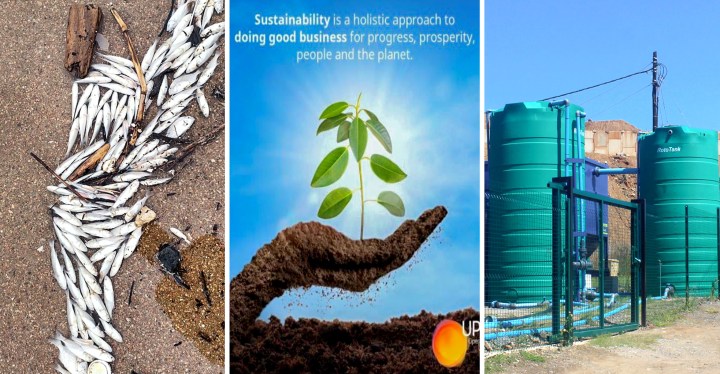
Global agrochemicals producer UPL has applied for permission to pre-treat chemically contaminated stormwater before releasing it into a river that flows into the sea next to Umhlanga, but there are still concerns over its quality.
A freshwater ecology consultant has reassured the public that the UPL poison decontamination plant in Durban is so effective that its treated water discharges comply with South African safe drinking water standards.
Dr Mark Graham, director of the GroundTruth group and consultant to UPL, gave this assurance at a public participation meeting at the Grace Family Church in Umhlanga last Thursday, 11 April.
But he declined a challenge to drink some of it.
Saddled with millions of litres of chemically contaminated stormwater in the wake of the July 2021 riots, the company has applied for permission to pre-treat the water before releasing it into a river that flows into the sea next to Umhlanga.
The water was contaminated by residual poisons from more than 4,500 tonnes of farm chemicals that burnt or leaked during an arson attack. It has been stored in a temporary Pollution Control Dam (PCD) in Cornubia for nearly three years (though some has already overflowed, been released on an emergency basis after treatment or been trucked at great expense to high-hazard waste dumps).
Now, in an attempt to find a permanent solution to this toxic legacy, the global agrochemicals group has applied for a water use licence from the national Department of Water and Sanitation (DWS). This would allow it to treat and discharge all the remaining water into a stream leading into the Ohlanga estuary, the scene of a major fish kill over the weekend of 5-7 April.
The cause of the most recent fish kill is still under investigation. Daily Maverick established that significant volumes of UPL’s treated water were released immediately before the fish kill, but the company argues that overflowing eThekwini municipality sewage works are the most likely cause.
‘Drinking water standard’
Graham began his presentation by taking local community members on a virtual tour of the UPL treatment facility at Cornubia by means of a video production.
In the video, he walks through the containerised treatment plant describing the functions of each phase of this “state-of-the-art tertiary treatment facility with multiple barriers”.
The process includes flocculation to remove floating sediments; ozone and ultraviolet treatment; sand filtration; and a final stage using activated carbon filtration.
The final result, he said, was drinking water which met South African Bureau of Standards SANS 241 requirements.
“It is at drinking-water standard suitable for domestic consumption.”
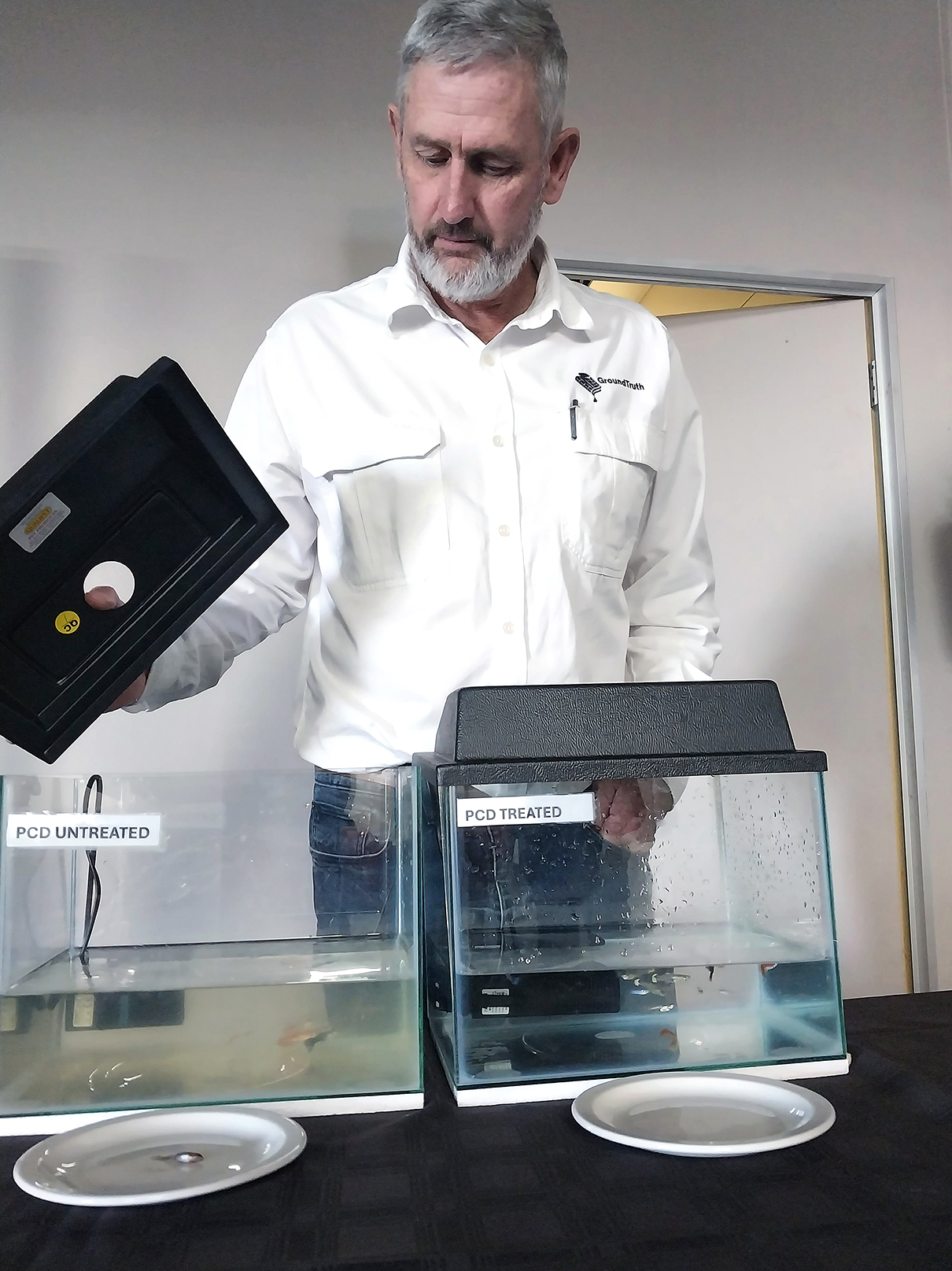
Dr Mark Graham peers into guppy tanks at Grace Family Church on 11 April 2024. (Photo: Tony Carnie)
To amplify his message that the water was also not harmful to river life, Graham left the podium to introduce what he called “the stars of the show” – a collection of guppies swimming quietly in two glass tanks at the back of the church hall.
Voila! … Exhibit A (a tank filled with visibly murky water marked “PCD untreated”) and Exhibit B (a tank with visibly clear water marked “PCD treated”).
Sadly, there was also an Exhibit C – one dead guppy on a white porcelain plate after it went belly up while swimming in Exhibit A.
Graham explained that shortly after the most recent fish kill at Umhlanga, UPL consultants purchased guppies from a local pet shop and placed them in the two fish tanks.
Now, two days later, four of the guppies in Exhibit A had died, while all the guppies in Exhibit B were still swimming around very happily.
“So, we are completely comfortable [that the treated water is safe],” he said, “You can test it yourself … we will give you water samples [to compare],” he told the public meeting.
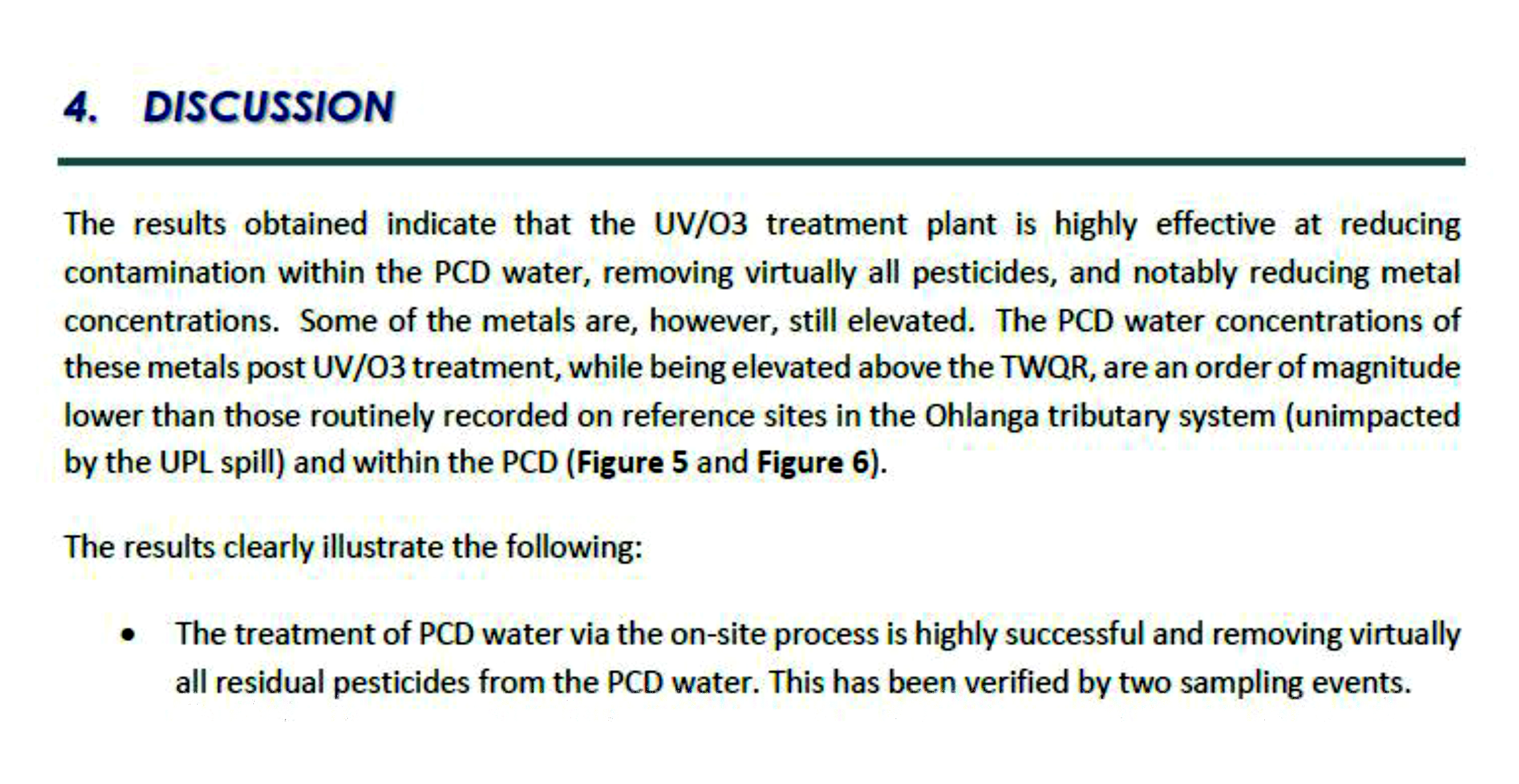
Dr Mark Graham’s overall conclusions. (Source: GroundTruth report January 2023)
Then came question time, and Daily Maverick had several – including the obvious one:
Given his assurance that UPL’s treated water complied with the SANS 241 drinking standard, would he accept a challenge to drink a glass, directly from the outflow pipe, once a week?
Graham did not respond immediately to that one, focusing instead on the other queries first.
Finally, however, he stated that he had been diagnosed with cancer and leukaemia five years ago and it would therefore “not be sensible to do that … so I am not going to do that on a weekly basis”.
Toxic heavy metals
Having read a copy of Graham’s January 2023 technical report on the efficacy of the UPL treatment plant, we also put it to him that his own report demonstrated that the process did not in fact remove all toxic materials from the PCD water.
For example, two separate tests conducted by UPL consultants in December 2022 and January 2023 suggested there was a 99-100% decline for four tested pesticides.
However, the treatment to remove four toxic heavy metals was much less efficient. The removal rate for arsenic in one of these tests was just 5%, improving to a 58% removal rate in another test. The percentage removal rate for the other heavy metals also varied. In another test, the amount of zinc in the final treated water increased after passing through the UPL decontamination plant.
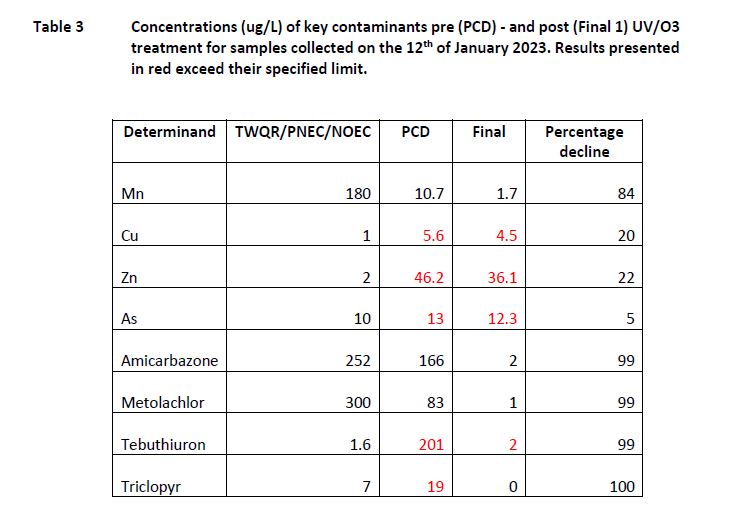
Considering that hundreds of farm chemical products and breakdown products leaked into the environment and PCD after the fire, we asked Graham if he could clarify the total number of pesticides tested after the treatment process (as the study tables indicated that only four pesticides were analysed).
Graham responded: “We are not saying it’s removing 100%.”
However, UPL consultants were satisfied that any residual pesticides or heavy metals in the treated water were at negligible levels (in the range of micrograms) and therefore posed no ecological or microbiological threats at these levels.
Based on expert toxicological advice, consultants had selected an initial range of about 56 priority pesticides for routine monitoring and analysis after the fire, but this had subsequently been reduced to about “three or four” for the treatment process analysis.
Dr Andrew Mather, a senior eThekwini municipality coastal policy engineer, also had several questions. He wanted to know the precise daily volume of treated water releases – noting that the company appeared to have provided three divergent versions to the authorities.
Graham said he was not certain of exact figures: “I will have to get back to you.”
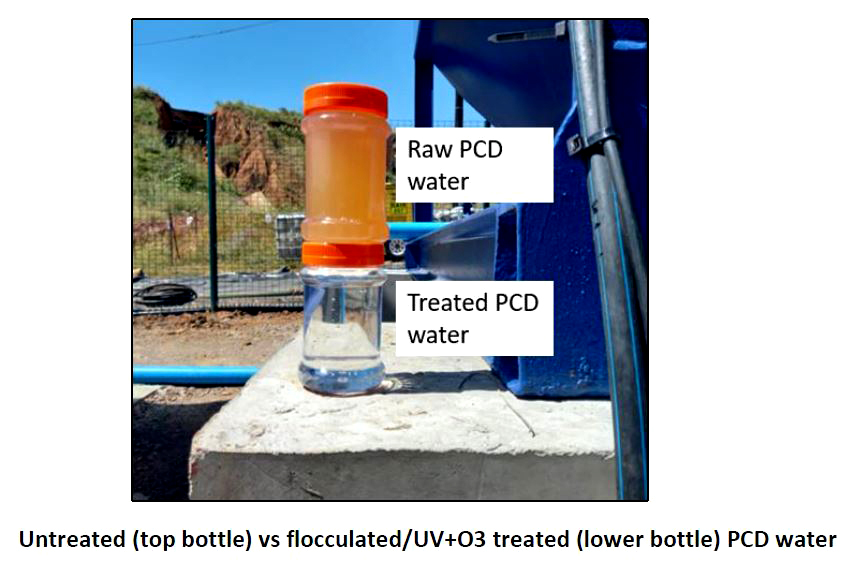
Samples of murky and clean water at the UPL treatment plant. (Image: GroundTruth report January 2023)
Mather expressed further concern that problems could arise if the plant was pushed beyond its design capacity. He noted that recent test results appeared to have been sent to the DWS, but had not been shared with members of the intergovernmental joint operations committee or the multi-stakeholder forum representing civil society and residents.
It was important that these most recent test results be made available to allow people to draw their own conclusions, he suggested.
In response, Graham noted that there had been “some anxiety in the media” recently about UPL treatment volumes, but said discharge limits were not being exceeded.
In its formal application to the DWS, the company states that: “The [Ohlanga River] system is essentially largely impacted, and the discharge of water classified as having no lethal/sub-lethal hazard to the receiving environment is not likely to change the system’s present ecological state.
“In fact, this may improve the water quality slightly by diluting some impacts from upstream of the discharge point.”
The public has until 15 May to submit any comments on the UPL licence application and can apply for registration as interested and affected parties through the public participation specialist, Rose Owen of Phelemanga Projects: [email protected]. DM


















 Become an Insider
Become an Insider
Smoke and mirrors. How can we trust that the water in exhibit B…the supposedly treated water from the UPL treatment plant is not just common or garden tap water. Come on Dr Graham – do not treat the public like gullible children! Guppies also die if they are removed from their tank to fresh water. Temperature plays a huge role as well. Give us real science – not hocus pocus!
In my opinion…UPL is dodgy and should have been properly punished for the first toxic spill in 2022. A slap on the wrist for serial offenders is never going to solve the oroblem!
That is absolutely shocking – the fact he will not drink the water – even a glass, is 100% indicative of his personal doubts. Unacceptable – makes me so angry! Our rivers and sea are polluted to such an extent and we still have deceitful companies trying to pull the wool over our eyes.
Well that’s no surprise. Dr Graham had zero credibility amongst people close to this affair before and now his weaseling has been exposed in the press. Thank heavens eThekwini Municipality is holding his feet to the fire. Would that national government did the same thing and started an effective prosecution.
I am not a specialist in water, but with a Ph. D. in civil engineering I am aware that some theories are just that, and not adequately proven.
I am a water treatment professional and I think we need some perspective. The process using advanced oxidation technology that Mr Graham demonstrated is a well established technology used to break down organic molecules such as pesticides into benign species. (Also used in the new Cape Town sewage re-use works treating sewage for replenishment of fresh water sources).
It is expensive and time consuming to test hundreds of samples for hundreds of chemical species, in industry we therefore would select a few representative species and track these through the process, which is probably why only 4 pesticides were named in the report.
I do not condone the mess that UPL caused, however it seems that they are trying to do the right thing by treating their toxic waste water. Using the process described they are addressing the potential for another major disaster (overflow of existing emergency containment), treating the effluent to SANS 241 and discharging it (safely) back into the environment. The sooner they start treating this water, the better as it limits the risk of another calamity.
Again perspective helps, the quality of this treated water will be much higher than many of the municipal potable supplies we currently have in South Africa, and significantly better than municipal discharges we have flowing into our rivers.
We have SANS 241, and if the water continually complies with this, then Mr Graham (and our esteemed journalist) can safely take a sip from the outfall.
I’m not so sure I agree Arno. Some oxidation processes will reduce organics but I’m not convinced these are the issue. The residual heavy metal contaminants are nasty and hard to remove, resin and ion exchange being a part of the process (activated carbon also helps a bit). To me the measures are of the wrong things and the fish kill is thr smoking gun in all of this. The municipality has overflowed for years. And suddenly now it kills fish? Rubbish. Exacerbated by who this company is and what they have done from the outset, since and currently. I dont trust them and I trust their water treatment even less.
Thanks Arno, that helps to give the perspective you say we need to take. Doesnt end the conversation, but enhances it.
Give ‘Em the Old razzle dazzle, Razzle Dazzle ‘Em. Give ’em the old Hocus Pocus…
If the good Doctor won’t drink it, at lease he should nominate on his behalf, the Director/CEO/Quality Control or equally senior management.. a glass a week as requested.
Is this consultant a trained scientist? This tank trick is not science or rigorous experiment and is also likely unethical. Surely scientists have to adhere to some animal cruelty standards.
Graham clearly does not trust the SANS241 analysis or treatment process…?